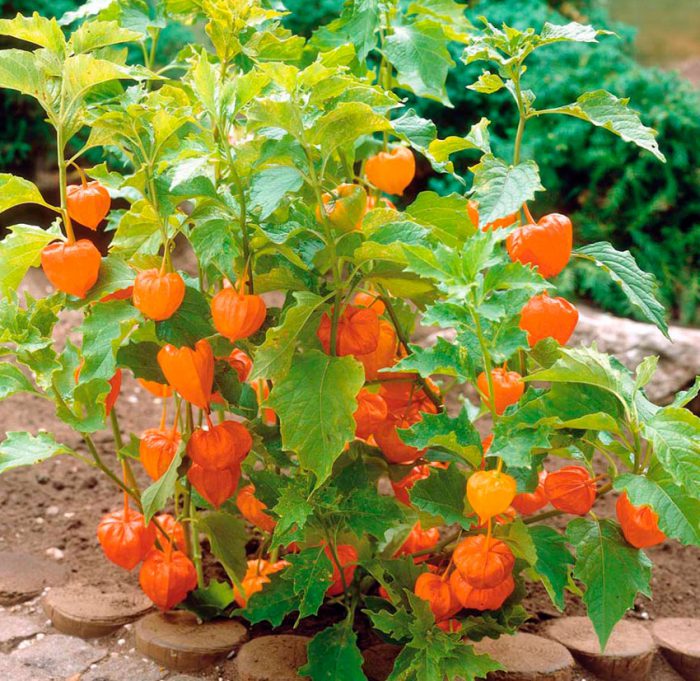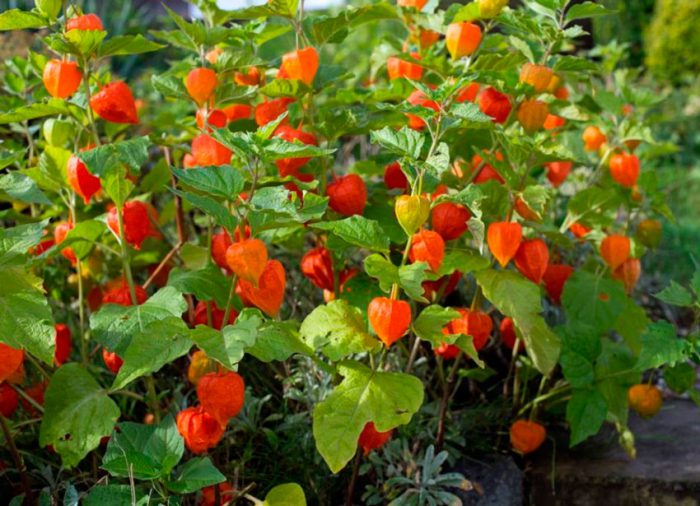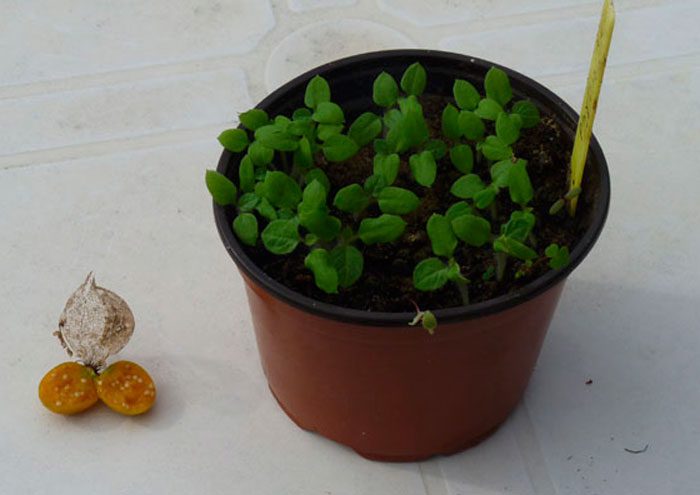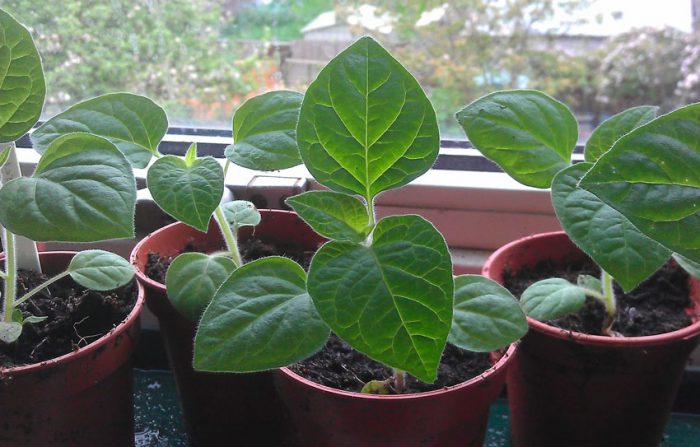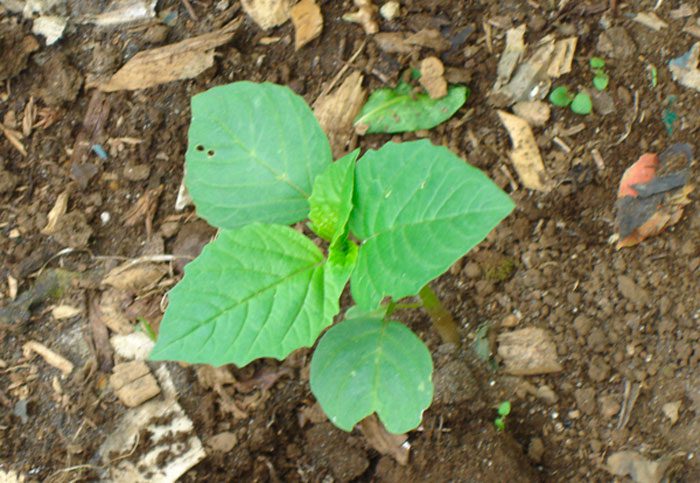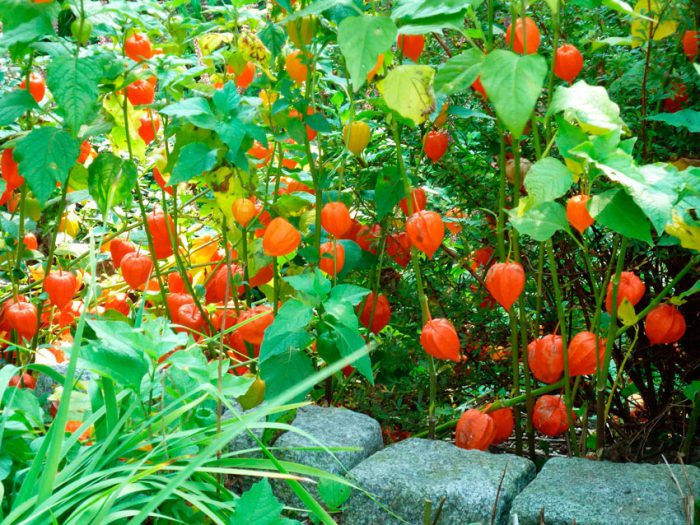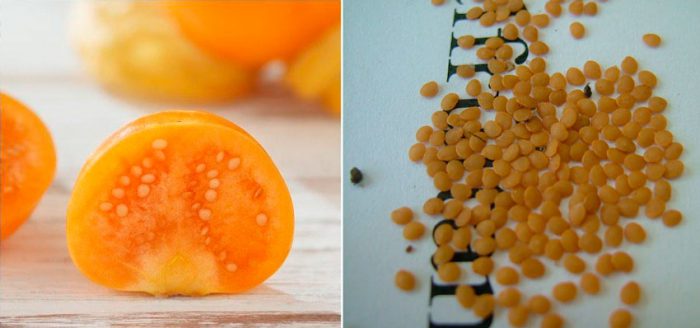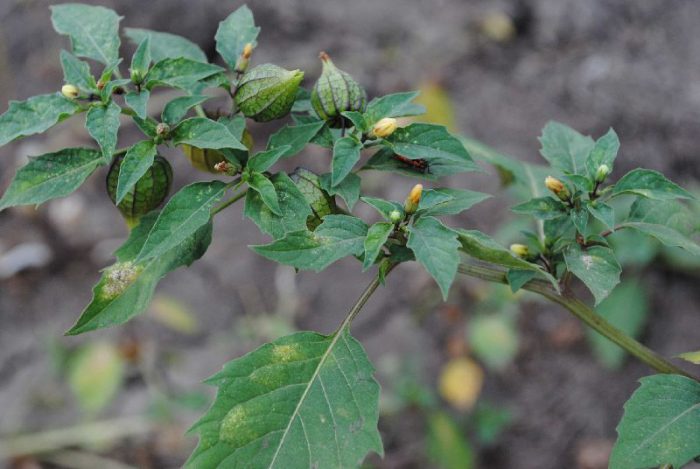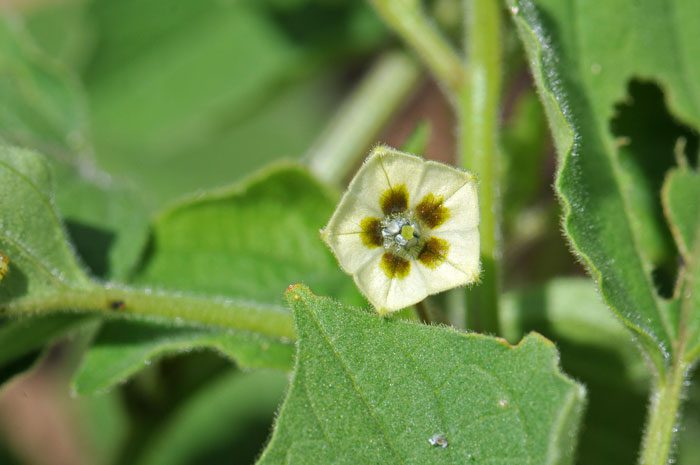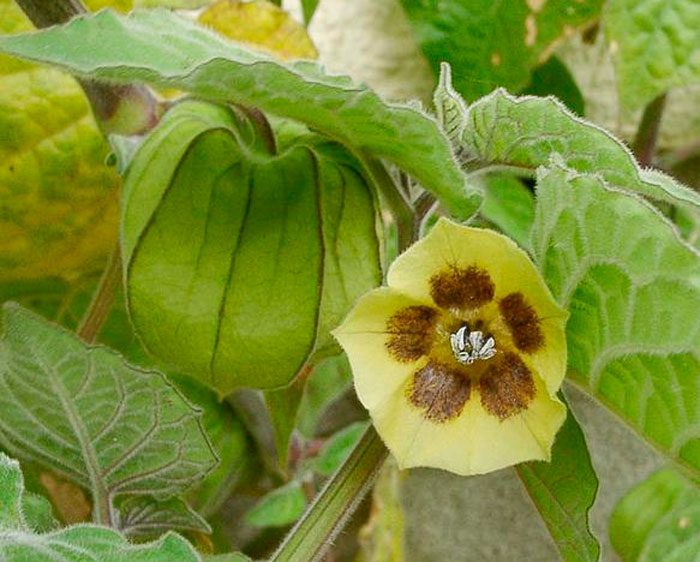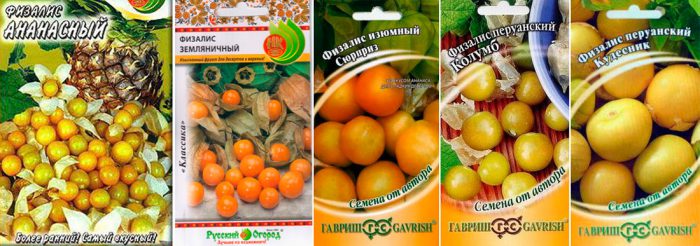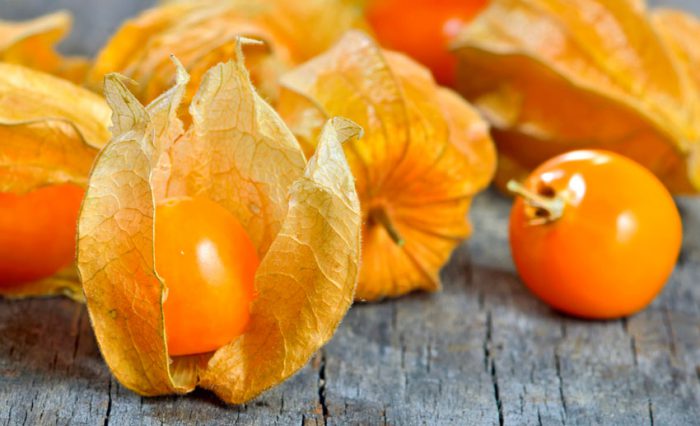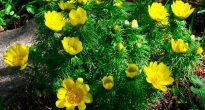Physalis (Physalis) is the largest genus of the Solanaceae family. It unites approximately 120 species. Physalis can be found in the wild in Europe, North and South America and Asia. Physalis is translated from Greek as "bubble", this name is associated with the shape of the growing cup, colored orange-red. Such a flower is also called emerald berry, dog cherry, earthen cranberry, bubble wort and marunka. This flower is very similar to tomatoes, as these plants are members of the same family. However, planting and caring for physalis is significantly different from tomatoes.
Content
Physalis features
Physalis is a herbaceous annual or perennial. Articulated shoots can be branched, angularly curved, or erect. They are completely naked or have a slight pubescence in the upper part. The height of the stems varies from 0.2 to 1.2 m. Gradually, the shoots grow stiff at the base. The leaf plates are oppositely located, while at the bottom of the shoot they are paired together or alternately located. Single axillary flowers grow along the entire length of the shoot. Swollen bell-shaped cups are painted in a rich color, inside there are two-nested spherical fruits of red or orange color - these are fragrant physalis berries. This plant is decorative, despite the fact that in a large number of its species, the berries have a high taste and can be eaten. Physalis perennial is called a Chinese lantern, such a plant looks great in a winter bouquet.
Growing physalis from seeds
Sowing
If physalis is grown in a region with a warm climate, then sowing should be done directly in open soil. This flower is cold-hardy, fruitful and early maturing. It multiplies easily by self-seeding, while the gardener will only have to make timely thinning of the seedlings. The seeds remain viable for 4 years. Immediately before sowing, the seeds must be put in a salt solution (5%) for a while.The floating seeds must be collected and thrown away, the same ones that have settled, should be washed and kept in a dark pink solution of potassium permanganate for 30 minutes. After that, they are washed and dried again. Sowing seeds in open ground should be done in April or the first days of May. They must be laid out in prepared grooves, while trying to keep the crops not thick, the row spacing should be about 0.3 m.After the seedlings appear, they should be thinned out, keeping a distance of about 25 centimeters between them. Torn seedlings, if desired, can be planted in another place, they will take root quickly and well, but they will have fruits later. Sowing can be done before winter and do it in October.
Seedling
In the middle latitudes, this plant is grown exclusively through seedlings. Physalis grown in this way will bear fruit a little earlier than it was sown in open ground. Sowing is carried out 4–6 weeks before the planting day in open soil. For this, you can use individual containers, the volume of which should be equal to 500 ml. You can also sow seeds in boxes, adhering to the 6x8 scheme, while such seedlings do not need a pick. Before starting sowing, seeds for 30 minutes. immersed in a strong solution of potassium manganese. After sowing, the containers are removed to a warm (about 20 degrees) place, the seedlings should appear after 7 days. If the containers are in a cooler place, then the seedlings will appear only after 4 weeks. The seedling must be provided with not too high humidity of the air and substrate, since otherwise they can get sick with a black leg. In this regard, the seedlings will need systematic airing, while keep in mind that physalis reacts negatively to a draft. It should also be taken into account that the plants need diffused bright light. In the event that the seedlings are provided with proper care and the necessary lighting, and they practically do not grow or are very elongated, they will need feeding. To do this, use a solution of bird droppings (water is mixed with droppings in a ratio of 20: 1), about 5 liters of nutrient mixture should go per 1 square meter. Then the substrate is spilled with clean water so that the plants do not get burned.
Picking
If the seedlings are very dense, then a pick will be required. After the plants have 2 true leaf blades, they are seated in individual cups, while trying not to damage the overgrown root system. Physalis sown in individual containers do not need picking, they are grown in them until the day of disembarkation.
Planting physalis in open ground
What time to plant
Seedlings are planted in open soil after 5 or 6 leaves have developed. It is recommended to do this on a rainy day or in the second half of the day. For landing, you should choose a well-lit area, while the soil should be slightly alkaline or neutral. Physalis is recommended to be planted in the place where cabbage or cucumbers were previously grown. At the same time, where peppers, eggplants, physalis, potatoes or tomatoes grew, such a plant should not be planted for 4 years, since all these crops are susceptible to infection by the same diseases, while their pathogens can be in the soil for a long time. The site should be prepared at least half a month before planting, while wood ash and humus should be added to the soil for digging. You cannot use fresh manure to fertilize the site.
Landing features
When planting physalis, it should be borne in mind that most species and varieties are highly branching. Therefore, planting seedlings should be staggered with a step of 50 centimeters. Also, during planting, it should be noted that tall varieties need a garter. The depth of the planting hole should be such that the planted plant plunges into it to the first true leaf plate.If the seedlings are overgrown, then first 1.5 liters of water is poured into the hole, and then the plant is lowered into it with a slope directly into the water, while it is necessary that the roots straighten out on their own. Then the hole is covered with soil, which is well tamped. If the seedlings are not overgrown, then they are planted as usual, and then watered very well. To reduce the number of watering, weeding and loosening, the surface of the site should be covered with a layer of mulch (peat).
Physalis care in the garden
Planting and growing physalis is quite simple. During the growing season, such flowers need to be systematically watered, and after this procedure, remove weeds and loosen the soil surface. They should also be regularly fed using organic fertilizers (solution of chicken manure (1:15) or mullein (1:10)). Top dressing is carried out only after watering. If the summer period turned out to be rainy and cool, then the physalis bushes will need to be hilled. The plant does not need pruning and pinching, but all because the berries grow in the branches of the shoots. Therefore, the harvest directly depends on the branching of the bush.
Physalis propagation
How to grow physalis from seeds is described above. You can also propagate it by cuttings and lateral processes. Physalis ornamental grows a large number of shoots from a creeping rhizome, which is not very deep under the soil. Therefore, in spring or autumn, you can separate and dig out a part of the rhizome, on which there should be developed shoots, which is then planted in a new place. Cuttings need to be harvested in July, for this, the upper parts of the shoots with two or three developed internodes are cut off. Then, for rooting, they are buried in loose soil by ½ part. At first, the cuttings will need shelter, for the creation of which perforated film is used. It will be possible to remove the shelter only when the leaf plates on the cuttings return their previous turgor. During rooting, cuttings should be watered on time and protected from direct sunlight.
Diseases and pests
Physalis has a fairly high resistance to disease. However, it can be struck by a disease such as mosaic, and those instances that are not properly cared for are the fastest to become infected. You can find out that the bush is affected by the mosaic by the color of its leaf plates, it becomes contrasting and consists of spots of pale green and dark green. In infected bushes, the number of fruits is reduced by half. It is impossible to cure such a disease. In this regard, the infected specimens must be dug up and destroyed. Then the site must be shed with a strong solution of potassium manganese.
Due to high humidity, physalis seedlings may develop black leg disease. From this, at the base, the stem turns black, which leads to the death of the plant. For preventive purposes, the following care rules should be adhered to: it is necessary to systematically loosen the surface of the substrate, thin out the seedlings in time, ensure rare but abundant watering, which is carried out in the morning.
All nightshades suffer from phytosporosis. This disease most often appears in rainy weather during fruit ripening. As a result, brownish subcutaneous spots are formed on the surface of the berries, such a fruit can no longer be eaten. To avoid the appearance of phytosporosis, it is necessary to spray the bushes with a solution of Bordeaux liquid (1%) before the ovary forms.
Of the pests, the most dangerous for physalis are wireworms and bears, which injure its roots. To protect the plant from the bear, it is planted in a plastic ring. To do this, you need plastic bottles with a volume of 2 liters; they cut off a narrow neck and bottom. The remaining middle section needs to be cut in half to make 2 rings. The resulting ring is first installed in the prepared planting hole, then the plant itself is planted.When the hole is covered with earth, it is important that the ring rises 50 mm above its surface. Thus, the young bush will be reliably protected from the bear.
To combat the wireworm, bait is used. Several small holes should be dug on the site and hay or semi-rotted grass should be put in them, on top of which boards should be laid. After a day or two, it is necessary to check the bait, since a lot of wireworm should already accumulate in it. The bait must be carefully removed and destroyed. Plowing or deep digging, carried out in the autumn, will also help in the fight against this pest. The fact is that part of the wireworm larvae in this case will be on the surface of the ground and freeze in the winter.
However, it should be remembered that physalis is quite resistant to various diseases and if it is provided with proper care and optimal conditions for growth, then it will not suffer from pests or diseases.
Physalis after flowering
Seed collection
The berries are cut off along with a little dried up spectacular cups on a sunny day, 1.5-2 months after the physalis is transplanted into open soil (in August or September). Ripening of berries does not occur at the same time, so those from the bottom become ripe much faster and fall to the surface of the site. They can be collected and used for food or for recycling. Also, seeds can be extracted from these berries, if necessary. Take ripe berries and use a knife to divide them into 2 halves. Then they should be immersed in rainwater for 24 hours, and then the pulp is rubbed through a sieve. The seeds must be washed and dried.
Wintering
If a decorative perennial physalis is grown, then the aerial part should be cut off in the autumn. It can be used to create very beautiful dry bouquets. The leaf plates must be cut off, and the shoots with fruits, which are hidden in bright covers, are hung up so that they dry. The surface of the site for the winter should be covered with a layer of mulch (peat). Berry and vegetable annuals after the fruits are harvested must be disposed of, after which the soil on the site should be dug up.
Types and varieties of physalis with photos and names
Edible physalis species are divided into physalis vegetable and physalis berry. The following types belong to the physalis berry: Florida physalis, pubescent physalis (either raisin or strawberry) and Peruvian physalis, which has become increasingly popular with gardeners of middle latitudes in recent years, as well as their various varieties.
Physalis Florida (Physalis floridana)
Possesses delicious sweet berries, which have virtually no acidity and fruity flavor. The jam made from them is very similar in taste to sweet cherry jam, in this regard, it is recommended to add geranium leaves to it.
Physalis raisin (Physalis pubescens)
This species has a more refined taste. The berries are sweet with a slight sourness, as well as with a well-noticeable aroma and aftertaste of pineapple. If you squeeze juice out of them, then it will taste similar to tangerine. Such berries can be stored for about 3-4 months (sometimes up to 6 months), while after some time they become a little withered. The dried berries taste similar to raisins.
Physalis Peruvian (Physalis peruviana)
Compared to raisins, this species has less sweet fruits, but their fruity smell and taste are more pronounced. Moreover, the amount of sugar and acids in them is almost the same as in garden strawberries. The fruits are relatively tender, so they cannot be stored for a long time.
The most popular varieties of berry physalis:
- Pineapple... The variety is early maturing. The very small, sweet berries have a pineapple scent. They are suitable for fresh consumption or for making candied fruits and jam.
- Strawberry... The bushes reach a height of 0.7 m, they grow sweet amber berries with a strawberry smell.They are eaten dried and fresh, as well as compotes, desserts and jams are made from them.
- Physalis raisin Surprise... A low-growing annual plant is distinguished by its unpretentiousness and strong pubescence. The variety is early maturing. Berries are eaten fresh or used for making desserts.
- Columbus... Such a tall plant loves warmth. The variety is late ripening. The fruits contain a large amount of pectin, vitamins and trace elements. They are consumed fresh, and also used to prepare drinks and desserts.
- Sorcerer... Very large berries of a flattened shape and orange-brown color have a sweet-sour taste with a slight grapefruit bitterness and a pronounced strawberry smell. Juice made from fruits is similar to orange juice, but it has a brighter bouquet.
Physalis Mexican (Physalis ixocarpa)
Physalis vegetable is represented by one species - Mexican physalis (Physalis ixocarpa), or glucose-fruited, as well as its varieties, which are many. In such a plant, the fruits are very large and similar to tomatoes. In this species, there are tall varieties, as well as low-growing ones. The color of the fruits can be green, yellow or purple, they have different shapes and sizes. These plants are not thermophilic and have a high yield. Fresh fruits are not very tasty in comparison with berry species. However, they are widely used for making pickles, marinades, salads and caviar, which are excellent. The most popular varieties in mid-latitudes:
- Ground Gribovsky... This mid-early variety is distinguished by its yield and frost resistance. The bush is about 0.8 m high and has semi-erect branches. The sweet-sour pale green fruits weigh about 60 grams.
- Confectionery... The mid-season variety has large round fruits, slightly sour taste and dark or pale green color. They are used for making marinades, pickles and caviar, as well as homemade desserts.
- Kinglet... The variety is early maturing. Used for the preparation of desserts and canned vegetables.
- Moscow early... The variety is early maturing. The branches are practically lying. The pale yellow sweet fruit weighs about 80 grams.
Physalis decorative (Chinese lanterns)
It is a herbaceous perennial plant. Any part of this plant contains poison, so you cannot eat its fruits. But landscape designers are happy to use such physalis in their work. Such a plant looks most impressive in the last summer or first autumn weeks. It was at this time that his boxes turn a rich orange color.
The most popular varieties:
- Franchet... It is often grown as an annual plant. The height of the bush is about 0.9 m, the length of oval leaf plates widened to the base is about 15 centimeters. No more than 15 boxes grow on one stem - these are the fruits of this plant, which are dressed in cups of a saturated color.
- Alkekengi... The boxes of this species are colored red, orange or yellow.
Useful properties of physalis
Edible physalis berries include a number of substances in their composition, such as: dietary fiber, carbohydrates, fats, proteins, structured water, vitamins A and C, trace elements iron and zinc and macronutrients potassium, calcium, sodium, phosphorus and magnesium. These fruits have a diuretic, hemostatic, choleretic, antimicrobial, analgesic and anti-inflammatory effect. With the help of infusions and decoction, urolithiasis, edema, gout, bronchitis, rheumatism, hepatitis and cystitis are treated. If there are fresh fruits, then this will improve the state of health with dysentery, dermatosis or hypertension.
Contraindications
You cannot eat the berries of decorative physalis, because they contain poison! The cups, in which the berries are placed, contain alkaloids and fizalin - these are toxic substances.If they enter the body, they can greatly harm it, so you need to be extremely careful.
If you care for physalis correctly and provide it with optimal conditions for growth, then you will get a rich harvest of fragrant berries, which are not only very tasty, but also incredibly healthy.

